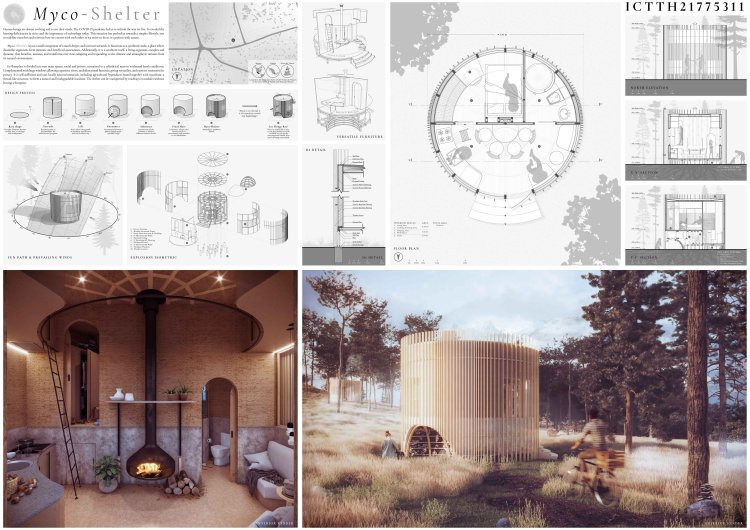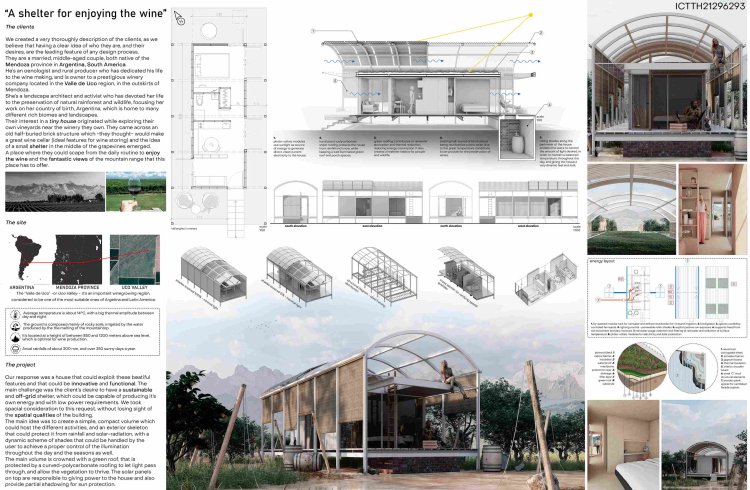Winners of Impact Competitions' Tiny House 2021 Architecture Competition.
Announcing the Winners of our Impact Competitions' Tiny House 2021 Architecture Competition.

Announcing the Winners of our Impact Competitions' Tiny House 2021 Architecture Competition.
The winning proposals were able to enhance the concept of home by changing topography and spatial limitations, resulting in a diverse range of typologies adapting to the context.
Participants were challenged to design a Tiny House for 2 people that would provide comfortable living accommodation. The design and concept of the house should be innovative, creative and sustainable. The relation between the house’s interiors and exterior surroundings should be taken into consideration. The proposed solution should be based on a strong concept
Over the past two years, most of the world's population has retreated to their homes for the majority so as to survive and embrace a more resourceful means of living. This scenario has presented designers with a unique opportunity to redefine the idea of a “Home”. The inclination of the users to follow simpler and more efficient ways of living, coupled with rapid development in technology and materials, has paved the way for a great opportunity to create a versatile and innovative personal space
Impact Competition thanks all the competitors for participating in this competition and for contributing to this competition's research.
Participants from more than 100 countries contributed valuable concept ideas to the contest, which was evaluated by a panel of international experts. The winning projects have been awarded a total cash prize of $10,000 distributed to the first 5 teams winner.





The esteemed jury for judging this competition consisted of Nguyen Hoang Manh (MIA Design Studio), Luis Ricardo, David Correa, Lui Hanxio, Taichi Kuma ( LLLab), Cesar Guerrero, Ana Cecilia Garza (S-AR), Daniel Mangabeira, Henrique Coutinho, Matheus Seco (Bloco Arquitetos), João Tiago Aguiar (João Tiago Aguiar Arquitectos), Gerardo Broissin (Broissin Architects), Nader Tehrani (NADAAA)
The top fives winners were awarded total prize money of $10,000 while ten entries received Honourable Mentions and two special mentions. Here are the winning entries. The full result for the competition TINY HOUSE 2021 ARCHITECTURE COMPETITION can be found on https://impactcompetitions.net/result/1
WINNERS
FIRST PLACE-

DANAHE ZIEHL TORRES - JOSé ANTONIO VICTORIA MARTíNEZ (Mexico)
MYCO- SHELTER
Human beings are always evolving and so are their necds. The COVID-19 pandemic led us to rethink the way we live. It revealed the housing deficiencies in cities and the importance of technology today. This situation has pushed us towards a simpler lifestyle, one to redefine ourselves and reinvent how we coexist with each other as we strive to do so in symbiosis with nature.
Myco- Shelter is just a small component of a much deeper and intricate network. It functions as a symbiotic node, a place where dissimilar organisms form intimate and beneficial associations. Additionally, it is a symbiont itself, a living organism, complex and dynamic, that breaches, mutates, and transforms over time; adapting and responding to the climatic and atmospheric variants from its natural environment
SECOND PLACE -

CLéMENT VIGNES - MARTY ILIEVSKI, - CAMILLE DESILLE (France)
THE FOLDING HOUSE
Who said tiny? The principle of the folding house is to allow users to expand their houses according to the season, the weather and the context in which it is located. With climate change, temperatures are more and more extreme, we think that this house must be able to adapt to these extremes.
In winter, the house is a self-sufficient tiny house, with a wood stove, solar panels, a rainwater collection system and two gas bottles if the light does not allow to generate enough electricity. It benefits from through openings in all the room. It is composed of wood frame walls insulated with hemp wool and clad with wood. The house protects itself from the cold. The interior heat is preserved.
In spring and summer the heat increases. We live more outside and want to enjoy it. The house expands in consequence. The facades turn and become a floor, It becomes additional spaces between the interior and the exterior. These spaces are covered by a waterproof tent, protecting us from rain, sun and mosquitoes. A system of motorized jacks allows its deployment. The house remains autonomous in summer and benefits from the same devices, solar, water, that in winter.
THIRD PLACE-

LENNY LEW LEE LIANG LEW - CHOO WAI HANG (United Kingdom)
SUNGAI LIMA VILLAGE. MALAYSIA
Sungai Lima Village, located in an island called Pulau Ketam at the west part of Malaysia. It is well known for their wooden houses rested on wooden stilts and their unusual amount of long bridges for local fishermen's to dry their catch as the village is also well known for their dried salted fish.
The fishermen would stand under the sun each day to flip and rotate each fish so that all the fish they caught would be dried equally on both sides while maintaining the exact texture they wanted for the dried fish. Despite so, most of the bigger fish still end up spoiled as the time precision to flip can be vary.
Our design proposal seek to improve the drying fish technique while providing learning experiences for visitors. Each house has its own rotating mechanism for drying fish that located at the front part which extends from the unused space of the roof to ensure the fish would receive adequate sunlight to dry.
One could rotate the mechanism while hang the fish at the bar of the mechanism with a poll. Each mechanism of the house could dry up to 160 fish.
SPECIAL MENTIONS –
RUILAN JIA (China)
XYZ Slider House

MATIAS DABBAH - JEREMIAS DABBAH (Peru)
A Shelter for Enjoying the Wine

Honourable Mentions –
LENA SCHLEICHER - VICTORIA PEIL (Germany)
Hive Home

YUANG LI (China)

LUCIA LOPEZ VIñUELA - GUILLERMO BERNALDO DE QUIRóS GONZALO (Spain)
Microhome for Roommates

JOSHUA NIEVES (United States)
Portulaca Cabin

CECILE NGOC SUONG PERDU - Hồ NGUYễN NGọC Hà (Vietnam)
MSF Pod

MAHMOUD WAHDAN - HAGER SAID ALFRARGY - AHMED ESSAM ATTIA (Egypt)
The Freed

FEYISITAN FAKOLADE - ABUBAKAR SHEHU BANGAJE (Nigeria)
Ilé Ireti “House of Hope”

VICTOR BARRENECHEA - VICENTE FLORES - GABRIELA CASTILLO (Chile)
A Home for a Marine Biologist

CHANASIT CHOLASUEK - APICHART SRIROJANAPINYO (Thailand)
The Suitecase

DUY ANH VU TRAN (Vietnam)
Float House

